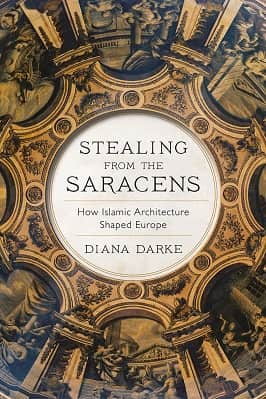
| Stealing From The Saracens |
| Diana Darke |
| 483 |
| |
| PDF Direct Download Link |
| Click for Hard Copy from Amazon |
Stealing from the Saracens – How Islamic architecture Shaped Europe by Diana darke
STEALING FROM THE SARACENS – HOW ISLAMIC ARCHITECTURE SHAPED EUROPE
Book’s preface
This book is dedicated to Notre Dame.
The catastrophic fire of 15 April 2019 was also the spark that ignited this book, once I saw how little the cathedral’s architectural backstory was understood.
I want to acknowledge the genius of Notre Dame’s medieval architects and masons, whose painstaking and devoted labours over the course of two centuries produced a prodigious organic structure that lived and breathed the history of France, its revolution, the coronation of Napoleon I, and the funerals of many presidents.
It became an eternal resident of the city, a spiritual core, a comforting presence—its immortality, perhaps, taken for granted.
As today’s engineers struggle to stabilise the structure, the magnitude of the task ahead is becoming clear. The French parliament has passed a law requiring the cathedral to be rebuilt exactly as it was, but therein lies the challenge.
President Macron’s vow to reconstruct in five years is way off the mark. Ten is more realistic, probably longer.
An estimated 1,300 oaks were felled to build the cathedral, but France no longer has trees of the same size and maturity.
Even beyond the issues inherent in replicating the ancient materials, there is another, infinitely more complex problem.
How can we re-create, in our computer-driven age of precision planning, the building’s original energy and force?
Guided by instincts honed through generations of experience and passed down from master to apprentice, the builders left no records. Nothing was written down beyond a few unscaled drawings.
The danger is that, in our rush to reconstruct Notre Dame‘ exactly as it was with the aid of our digital devices, we may end up losing the building’s very soul, unwittingly expunging the subtle imperfections that are integral to its essence and identity.
These are the mysteries that lie at the heart of medieval Gothic or ‘Saracenic’ architecture, the origins of which this book seeks to unravel.
As the dark shadow of the 2020 Coronavirus pandemic forces us to confront new uncertainties, one likely outcome—even in those who profess no faith—is the rediscovery of religious architecture and its power to calm and heal.
May the future Notre Dame remain forever true to the spirit of those mysteries.
Book’s Introduction
This book has risen from the ashes of the 15 April 2019 fire at Notre-Dame de Paris.
On that fateful night, the world was gripped by images of the cathedral engulfed in flames.
No one imagined that a building on fire could spark such interest and mesmerise global audiences for days on end. The French nation went into mass mourning on a scale that took everyone by surprise.
Why? What did this building represent to the French and to the world? In due course, statements by international leaders, not least French president Emmanuel Macron himself, would suggest that the cathedral somehow encapsulated French nationhood. All of France was burning in sympathy.
In a country where statistics show that before the fire only 5 per cent of the population was church-going and 47 per cent described themselves as non-practising Catholics, what could explain such an outpouring?
Part of it, without doubt, was a reaction. France has a long tradition of laïcité, secularism, that began with its revolution in 1789, and its constitution today guarantees that ‘all citizens regardless of their origin, race or religion are treated as equals before the law.’ But the twenty-first century brought unforeseen challenges.
During Europe’s migration crisis in 2015, France found itself overwhelmed with Arab and African refugees, most of whom were Muslim.
Later that year, the streets of Paris were convulsed by a series of terrorist attacks, inspired by the extremism of the Islamic State.
In response to these upheavals and the perceived threat of Islam, many sought to revive a Christian national identity.
To read more about the Stealing From The Saracens book Click the download button below to get it for free
or
Report broken link
Support this Website
for websites